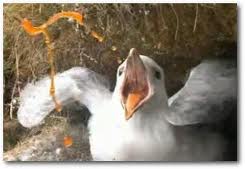An anatomical, physiological or behavioral characteristic that serves a transient, age-specific, biological function during development, and which may occur relatively independently of experience. It may be appropriate for survival during one phase of development (e.g., during prenatal life), but unnecessary or even incompatible with adaptations required for later phases. As a consequence, they must be eliminated, suppressed or reorganized in the course of further normal development. A somewhat startling example of an ontogenetic adaptation involving a fulmar chick putting it to use can seen in the figure below.

When threatened by predators the fulmar chick vomits orange-colored, strongly smelling and sticky oil at predators. If it sticks to the predator’s feathers, then it glues together so that the bird cannot fly. This results in the predator becoming waterlogged, with the loss of buoyancy and thus death by drowning. While chicks also spit the oil at their parents, but they are immune to the effects (lucky for the parents as parental recognition is not achieved until the chicks are 3 weeks old). Although adult fulmars can spit the oil, the chicks have a better aim and can vomit repeatedly, an ability lost later, but one that helps fulmar chicks to survive during when they are most vulnerable.
See Altricial, Antecedent-consequent relationship, Cajal-Rezius cells, Egg-tooth (or crabuncle), General movements, Metamorphosis (or indirect development), Newborn imitation, Newborn swimming, Ontogenetic development, Ontogeny, Ossification, Precocial, Progesterone, Quantitative and qualitative regressions, Radial glial cells
